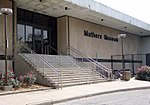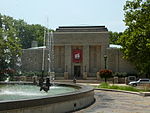University Courts Historic District
Buildings and structures in Bloomington, IndianaColonial Revival architecture in IndianaGeographic coordinate listsHistoric districts in Monroe County, IndianaHistoric districts on the National Register of Historic Places in Indiana ... and 6 more
Houses in Monroe County, IndianaHouses on the National Register of Historic Places in IndianaLists of coordinatesNRHP infobox with nocatNational Register of Historic Places in Monroe County, IndianaNeoclassical architecture in Indiana

The University Courts Historic District is a historic district and neighborhood in Bloomington, Indiana, United States.
Excerpt from the Wikipedia article University Courts Historic District (License: CC BY-SA 3.0, Authors, Images).University Courts Historic District
East 8th Street, Bloomington
Geographical coordinates (GPS) Address Nearby Places Show on map
Geographical coordinates (GPS)
| Latitude | Longitude |
|---|---|
| N 39.169583333333 ° | E -86.524166666667 ° |
Address
East 8th Street 861
47408 Bloomington
Indiana, United States
Open on Google Maps





